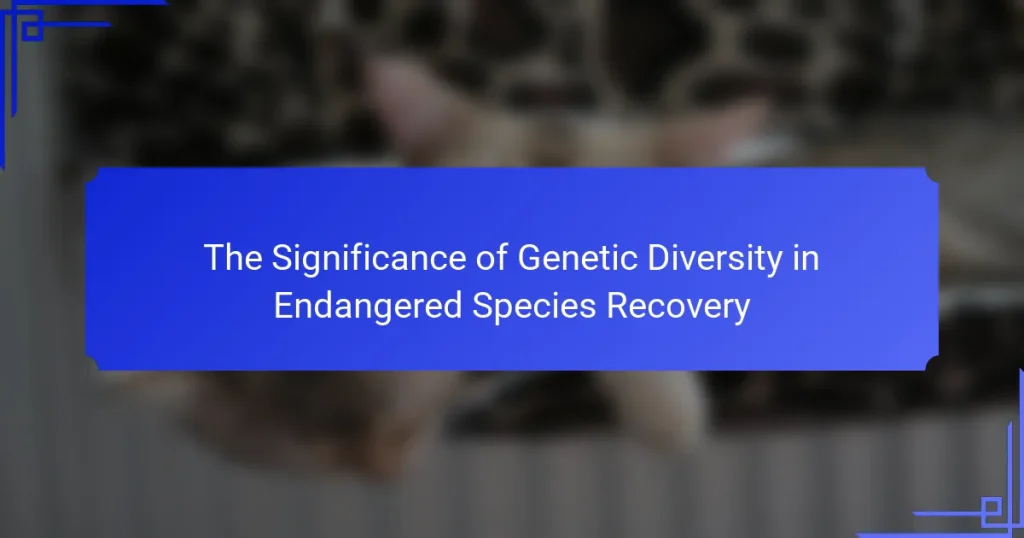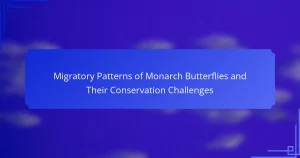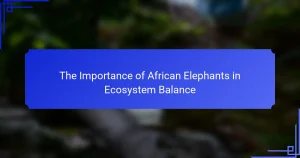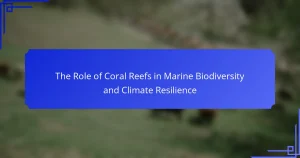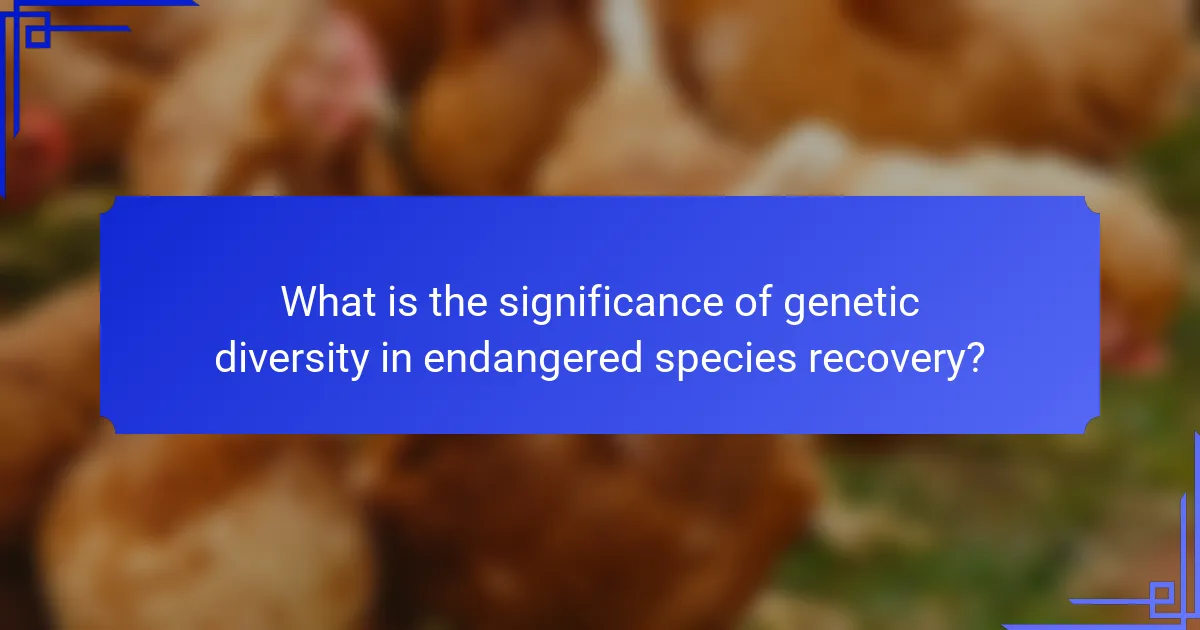
What is the significance of genetic diversity in endangered species recovery?
Genetic diversity is crucial for the recovery of endangered species. It enhances a population’s ability to adapt to environmental changes. This adaptability is essential for survival and reproduction. Higher genetic diversity can lead to increased resistance to diseases. It also helps maintain healthy ecosystems by supporting various ecological roles. For example, the cheetah population has low genetic diversity, leading to health issues and reduced fertility. Research shows that populations with greater genetic variation are more resilient. This resilience is vital for long-term species survival and recovery efforts.
Why is genetic diversity important for species survival?
Genetic diversity is crucial for species survival because it enhances resilience to environmental changes. A diverse gene pool allows populations to adapt to new diseases, climate shifts, and habitat alterations. This adaptability is essential for long-term survival. For instance, species with low genetic diversity, like the cheetah, face higher risks of extinction due to their inability to adapt. Research indicates that populations with greater genetic variation have higher reproductive success and survival rates. A study published in the journal “Nature” highlights that genetic diversity is linked to the ability of species to withstand environmental stresses. Therefore, maintaining genetic diversity is vital for the health and longevity of species.
How does genetic diversity enhance adaptability in changing environments?
Genetic diversity enhances adaptability in changing environments by providing a broader range of traits within a population. This variation increases the likelihood that some individuals will possess advantageous characteristics. For example, diverse genetic traits can improve resistance to diseases or environmental stressors. A study by Reed and Frankham (2003) demonstrated that populations with higher genetic diversity have better survival rates under changing conditions. This is particularly important for endangered species, as they may face rapid habitat changes. Enhanced adaptability through genetic diversity can lead to more resilient populations capable of thriving despite environmental challenges.
What role does genetic diversity play in disease resistance?
Genetic diversity enhances disease resistance in populations. It increases the likelihood of individuals possessing various immune responses. Diverse genetic backgrounds allow for a broader range of defenses against pathogens. This adaptability is crucial when facing emerging diseases. Studies show that populations with higher genetic variation have better survival rates during disease outbreaks. For example, research on amphibians indicates that genetically diverse populations are more resilient to chytridiomycosis. In contrast, inbreeding can lead to reduced immune function and increased susceptibility. Thus, genetic diversity is vital for the health and survival of species facing disease threats.
What are the consequences of low genetic diversity?
Low genetic diversity leads to reduced adaptability in species. This makes them more vulnerable to diseases and environmental changes. For example, the cheetah population has low genetic diversity, resulting in increased susceptibility to health issues. Additionally, low genetic diversity can cause inbreeding depression, which reduces reproductive success and survival rates. Such consequences threaten the long-term viability of endangered species. Research shows that populations with higher genetic diversity are more resilient to stressors. Therefore, low genetic diversity can significantly impede recovery efforts for endangered species.
How does inbreeding affect endangered species populations?
Inbreeding negatively affects endangered species populations by reducing genetic diversity. Reduced genetic diversity leads to inbreeding depression. Inbreeding depression can result in lower fertility rates. It can also cause increased susceptibility to diseases. Additionally, inbreeding may lead to physical deformities and developmental issues. A study on the Florida panther found that inbreeding caused heart defects and low sperm counts. These effects hinder the survival and adaptability of populations. Consequently, inbreeding threatens the long-term viability of endangered species.
What are the implications of genetic bottlenecks for recovery efforts?
Genetic bottlenecks negatively impact recovery efforts for endangered species. They reduce genetic diversity within populations. This lack of diversity can lead to inbreeding depression. Inbreeding depression decreases fitness, reproduction, and survival rates. For example, the Florida panther experienced reduced genetic diversity due to a bottleneck. This led to health issues and lower population growth. Recovery efforts must prioritize increasing genetic diversity. Strategies include translocating individuals from other populations. Such actions can enhance resilience and adaptability in changing environments.
How can genetic diversity be assessed in endangered species?
Genetic diversity in endangered species can be assessed using various methods. One common approach is through molecular techniques, such as DNA sequencing. This method analyzes genetic variations within and between populations. Another method is the use of microsatellites, which are short, repetitive sequences in DNA. Microsatellites provide insights into genetic diversity and population structure.
Additionally, researchers may employ single nucleotide polymorphisms (SNPs) for a more detailed genetic analysis. SNPs are variations at a single base pair in DNA and can indicate genetic health. Furthermore, population genetic studies can assess gene flow and inbreeding levels. These studies often use software tools to analyze genetic data.
Field studies also contribute to understanding genetic diversity. Observing mating patterns and offspring viability provides practical insights. Conservation genetics combines these methods to inform management strategies. Overall, assessing genetic diversity is crucial for the conservation of endangered species.
What methods are used to evaluate genetic variation?
Common methods to evaluate genetic variation include DNA sequencing, microsatellite analysis, and single nucleotide polymorphism (SNP) genotyping. DNA sequencing provides detailed information about the genetic makeup of individuals. It allows researchers to identify variations at the nucleotide level. Microsatellite analysis examines short, repetitive sequences in the genome. This method detects variations in the number of repeats between individuals. SNP genotyping focuses on variations at single nucleotide positions across the genome. It is widely used due to its high throughput and cost-effectiveness. These methods are essential for assessing genetic diversity in populations. They help inform conservation strategies for endangered species recovery.
How do conservation genetics techniques inform recovery strategies?
Conservation genetics techniques inform recovery strategies by assessing genetic diversity within endangered populations. These techniques help identify genetic bottlenecks that may threaten population viability. For instance, low genetic diversity can lead to inbreeding depression, reducing fitness and adaptability. Genetic assessments also guide the selection of individuals for breeding programs. This ensures that genetic variation is maximized, promoting healthier offspring. Additionally, conservation genetics can identify distinct populations that require separate management strategies. By integrating genetic data, recovery plans can be tailored to maintain or enhance genetic diversity. Studies have shown that effective use of these techniques leads to improved survival rates in reintroduced populations.
What strategies can enhance genetic diversity in conservation efforts?
Strategies that can enhance genetic diversity in conservation efforts include habitat protection, genetic monitoring, and managed breeding programs. Habitat protection ensures that ecosystems remain intact, allowing species to thrive and interbreed. Genetic monitoring involves assessing the genetic health of populations to identify inbreeding or genetic bottlenecks. Managed breeding programs facilitate the controlled mating of individuals to increase genetic variation. Translocation of individuals between populations can also introduce new genetic material. Additionally, conservationists can utilize advanced genetic techniques, such as genetic rescue, to enhance diversity. These strategies have been shown to improve population resilience and adaptability, as evidenced by successful recovery cases in species like the Florida panther, where genetic interventions led to increased genetic diversity and population growth.
How can captive breeding programs contribute to genetic diversity?
Captive breeding programs can enhance genetic diversity by introducing controlled mating strategies. These programs often involve breeding individuals from different populations. This reduces inbreeding and increases genetic variation. A study by Frankham et al. (2010) highlighted that genetic diversity is crucial for species adaptability. Higher genetic diversity can lead to improved survival rates in changing environments. Captive breeding can also facilitate the reintroduction of genetically diverse individuals into wild populations. This practice helps maintain the overall health of species. Thus, captive breeding is vital for preserving genetic diversity in endangered species.
What is the role of habitat connectivity in promoting genetic exchange?
Habitat connectivity plays a crucial role in promoting genetic exchange among populations. It facilitates the movement of individuals between fragmented habitats. This movement allows for mating opportunities between genetically distinct populations. Increased genetic exchange enhances genetic diversity. Genetic diversity is essential for the adaptability and resilience of species. Research shows that connected habitats lead to higher gene flow. Higher gene flow results in healthier populations. Studies indicate that isolated populations experience inbreeding depression, reducing their survival chances. Thus, maintaining habitat connectivity is vital for the long-term survival of endangered species.
How does genetic diversity influence ecosystem resilience?
Genetic diversity enhances ecosystem resilience by providing a wider range of traits that can help species adapt to changing environmental conditions. Diverse genetic traits increase the likelihood that some individuals will thrive under stressors such as climate change, disease, or habitat alteration. For example, studies have shown that ecosystems with higher genetic diversity can recover more quickly from disturbances. Research by Elmqvist et al. (2003) in “Biodiversity, Ecosystem Functioning, and Human Well-Being” indicates that genetic variation within species supports ecosystem stability and productivity. This resilience is crucial for maintaining ecosystem services that humans rely on, such as clean water and food sources. Therefore, preserving genetic diversity is essential for the health of ecosystems and their ability to withstand environmental challenges.
What are the broader ecological benefits of maintaining genetic diversity?
Maintaining genetic diversity provides essential ecological benefits. It enhances ecosystem resilience against environmental changes. Diverse genetic pools allow species to adapt to shifting climates and habitats. This adaptability can lead to greater survival rates during ecological stressors, such as disease outbreaks. Genetic diversity also supports ecosystem services, including pollination and nutrient cycling. A study by the National Academy of Sciences found that genetic diversity improves the stability of ecosystems. Healthy ecosystems contribute to biodiversity, which is vital for overall ecological balance. Thus, preserving genetic diversity is crucial for sustaining healthy ecosystems and their functions.
How can genetic diversity impact the stability of ecosystems?
Genetic diversity enhances the stability of ecosystems by promoting resilience to environmental changes. It allows species to adapt to varying conditions, such as climate shifts or disease outbreaks. Higher genetic variation within populations leads to a greater likelihood of survival under stress. For example, diverse plant species can better withstand pests and diseases, ensuring ecosystem productivity. Additionally, genetic diversity supports complex food webs and ecological interactions. Studies show that ecosystems with higher genetic diversity are more robust and can recover faster from disturbances. This is evidenced by research indicating that coral reefs with diverse genetic backgrounds are more resilient to bleaching events.
What best practices can be implemented for fostering genetic diversity?
Implementing best practices for fostering genetic diversity includes habitat protection, breeding programs, and genetic monitoring. Habitat protection ensures ecosystems remain intact, supporting diverse species. Breeding programs, such as managed breeding in zoos, enhance genetic variation. Genetic monitoring tracks genetic diversity levels over time. These practices have been shown to increase population resilience. For instance, the Florida panther recovery program utilized genetic management to improve health and reproduction rates. Effective strategies also involve translocation of individuals to introduce new genes. Studies indicate that increased genetic diversity leads to improved adaptability to environmental changes.
The main entity of this article is genetic diversity and its significance in the recovery of endangered species. Genetic diversity plays a crucial role in enhancing adaptability, disease resistance, and overall population resilience, which are vital for the long-term survival of species. The article discusses the consequences of low genetic diversity, including inbreeding depression and reduced reproductive success, as well as methods for assessing and enhancing genetic variation through conservation strategies. Additionally, it highlights the ecological benefits of maintaining genetic diversity for ecosystem stability and resilience.
